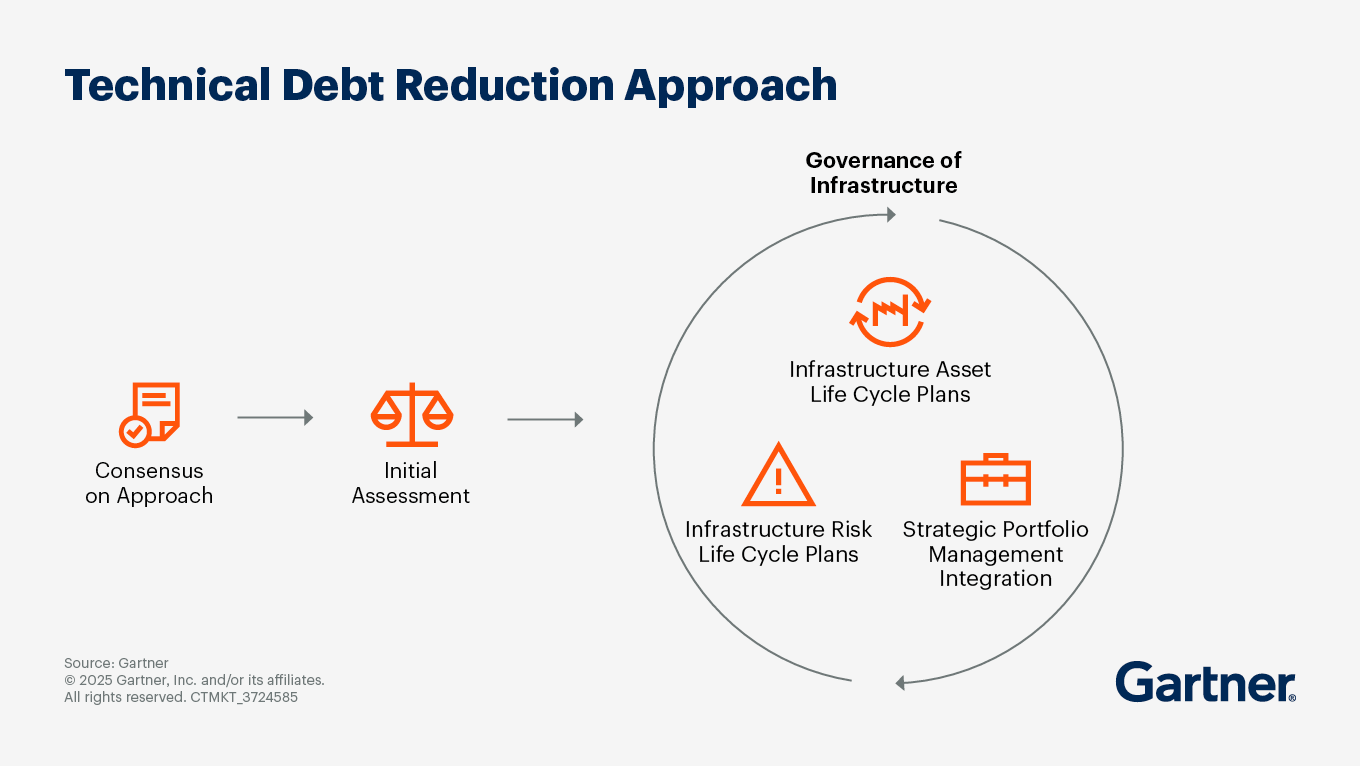Use a structured method to manage infrastructure technical debt.
- Gartner client? Log in for personalized search results.
Why enterprises fail to reduce technical debt
On average, about 40% of infrastructure systems across asset classes have technical debt concerns. Teams create technical debt when they “borrow” against long-term quality by making short-term sacrifices, taking short cuts or using work-arounds to meet delivery deadlines. Technical debt also arises over time as infrastructure ages. Ultimately, these debts impact performance, scalability, resilience and, eventually, increase customer dissatisfaction.
Reducing technical debt seems like an obvious area of prioritization, but it requires a diverse group of stakeholders to agree on the risk and work together towards the goal. Generally, there are three key factors that make reducing technical debt challenging: short-term savings, shiny object syndrome and stakeholder gridlock. Eventually, enterprises reach a point where a modernization project is unavoidable. However, these solutions often just fix the symptoms of a broader problem. Without targeting the main issues, the enterprise will revert back to its original state — buried in technical debt.
Launch a structured approach to manage technical debt
Gartner estimates by 2028, I&O leaders using structured methods for managing infrastructure technical debt will report 50% fewer obsolete systems than those who do not. Reducing and managing technical debt can be a complex undertaking for enterprise leadership. However, a strategic approach will help create a consensus among stakeholders and lead to better results.
Develop a consensus on approach
An effective plan to reduce technical debt requires shareholder consensus on enterprise-wide goals. Before work begins, co-create a charter with key stakeholders to establish clear guidance and avoid misunderstandings later in the process. The charter should include:
Expectations for ongoing management of infrastructure technical debt versus isolated projects
What program success looks like, and what value it will provide to the enterprise
Which groups need to be involved as key stakeholders
Who will be filling the roles of executive sponsorship, program leadership and infrastructure ownership
How key program decisions will be made, and how program governance will be performed
Which measures to use to oversee the program and determine its success
Conduct an initial assessment
One of the major challenges for reducing technical debt is an inability to agree on key risk areas amongst competing business priorities.
A consistent approach to assessing technical debt makes it easier to aggregate and present analysis in a useful format. Staff should evaluate based on four fitness factors: business value, financial resources, direct risk and indirect risk.
Infrastructure fitness assessments offer credible and consistent information about the current health of infrastructure. To provide a basis for all infrastructure life cycle management activities, I&O leaders should:
Identify and document entities of interest (e.g., specific components of IT infrastructure hardware and software likely to have high value) in the existing infrastructure
Apply valuation criteria and data to those entities
Scrutinize the entities to find technical debt reduction opportunities in the portfolio
Manage the lifecycles of the infrastructure portfolio
There are three primary drivers that need to be accounted for to minimize unnecessary infrastructure technical debt levels:
Infrastructure asset life cycles: Operating infrastructure components past their end of life or end of support without mitigations poses unacceptable costs and risks for digital business.
Infrastructure risk life cycles: High-value systems often provide opportunities for compelling cost savings or risk reductions, even if they have not yet reached end of life.
Strategic portfolio management needs: Mission-critical applications, products, platforms or services often need elevated levels of nonfunctional performance to achieve their potential benefits.
To meet these varied needs, adopt a graded approach for differentiating systems that tailors the depth and frequency of life cycle activities to their business value. This will keep the focus on areas that are most important and reduce efforts in areas that require minimal attention.
Maintain technical debt reductions
Once the organization has agreed on a technical debt management approach and gathered assessment data about the various infrastructure elements, implement a portfolio management approach to ensure ongoing assessment, life cycle management and governance of the organization’s infrastructure components.
The primary responsibility of the portfolio management approach is to ensure that expenditures in time, people and money are aligned with business outcomes in ways business leaders can understand. In addition, portfolio management can help reserve and supply each practice with the resources required to fully source any investments, programs or projects associated with technical debt reduction.
To begin, focus on governance of infrastructure. Select an infrastructure component to use as a pilot that is high value, has broad support for immediate action and no obvious obstacles. Once the owner drafts an infrastructure life cycle plan (i.e. estimated end of life and remediation plan, fitness assessments), initiate infrastructure governance of those plans.
After the governing committee approves the draft, begin remediation activities. Ensure the most current, approved plans and relevant information from the review are uploaded to a management repository. Authorize recurring governing committee activities and schedule them to ensure they fulfill their assigned responsibilities outlined in the charter. Once pilot efforts are successful, expand the scope of this work in phases over time to fulfill the goals of the charter.
Technical debt FAQs
What is technical debt?
Technical debt is the deviation of a system from any of its nonfunctional requirements.
How can leaders reduce technical debt levels and maintain infrastructure fitness?
Leaders can reduce technical debt levels by gaining buy-in on the technical debt reduction approach, conducting an initial assessment and putting governance of infrastructure in place around key life cycles.
Attend a Conference
Join Gartner experts and your peers to accelerate growth
Gather alongside I&O leaders on December 9 – 11 in Las Vegas to gain insight on emerging trends, receive one-on-one guidance from Gartner experts and create a strategy to tackle your priorities head-on.
Gartner IT Infrastructure, Operations & Cloud Strategies Conference
Las Vegas, NV

Drive stronger performance on your mission-critical priorities.
